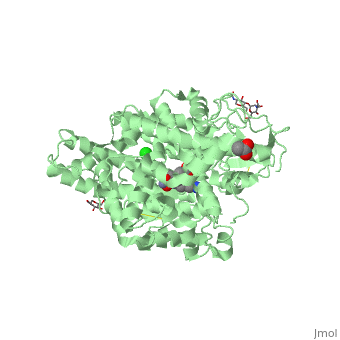ACE Inhibitor Lisinopril
From Proteopedia
(Difference between revisions)
(Undo revision 2688784 by Tom Sullivan (Talk)) |
|||
| Line 2: | Line 2: | ||
== Function == | == Function == | ||
| - | Lisinopril is an orally active angiotensin-converting enzyme inhibitor, or ACE inhibitor, used primarily to lower blood pressure. Lisinopril works by antagonizing the effect of the renin-angiotensin-aldosterone system (RAAS), which is a homestatic mechanism for regulating hemodynamics, water and electrolyte balance. During sympathetic stimulation or when renal blood pressure or blood flow is reduced, renin is released from the granular cells of the juxtaglomerular apparatus in the kidneys. In the blood stream, renin cleaves circulating angiotensinogen to angiotensin I (ATI), which is subsequently cleaved to angiotensin II (ATII) by the enzyme ACE. ATII increases blood pressure using a number of mechanisms. ACE inhibitors inhibit the rapid conversion of ATI to ATII, and also antagonize RAAS-induced increases in blood pressure. ACE (also known as kininase II) is also involved in the enzymatic deactivation of bradykinin, which is a vasodilator. When the deactivation of bradykinin is inhibited, bradykinin levels are increased and this can further sustain the effects of lisinopril by causing increased vasodilation and decreased blood pressure.<ref>National Center for Biotechnology Information. PubChem Compound Database; CID=5362119, https://pubchem.ncbi.nlm.nih.gov/compound/5362119 </ref> Overall, lisinopril inhibits the substances in the body that cause blood vessels to tighten, and as a result lisinopril relaxes the blood vessels and therefore lowers blood pressure and increases the supply of blood and oxygen to the heart.<ref>Helen, Allen (2016). Lisinopril: Lisinopril ACE inhibitor. Patient. Retrieved from: http://patient.info/medicine/lisinopril-an-ace-inhibitor-zestril</ref> | + | '''Lisinopril''' is an orally active angiotensin-converting enzyme inhibitor, or ACE inhibitor, used primarily to lower blood pressure. Lisinopril works by antagonizing the effect of the renin-angiotensin-aldosterone system (RAAS), which is a homestatic mechanism for regulating hemodynamics, water and electrolyte balance. During sympathetic stimulation or when renal blood pressure or blood flow is reduced, renin is released from the granular cells of the juxtaglomerular apparatus in the kidneys. In the blood stream, renin cleaves circulating angiotensinogen to angiotensin I (ATI), which is subsequently cleaved to angiotensin II (ATII) by the enzyme ACE. ATII increases blood pressure using a number of mechanisms. ACE inhibitors inhibit the rapid conversion of ATI to ATII, and also antagonize RAAS-induced increases in blood pressure. ACE (also known as kininase II) is also involved in the enzymatic deactivation of bradykinin, which is a vasodilator. When the deactivation of bradykinin is inhibited, bradykinin levels are increased and this can further sustain the effects of lisinopril by causing increased vasodilation and decreased blood pressure.<ref>National Center for Biotechnology Information. PubChem Compound Database; CID=5362119, https://pubchem.ncbi.nlm.nih.gov/compound/5362119 </ref> Overall, lisinopril inhibits the substances in the body that cause blood vessels to tighten, and as a result lisinopril relaxes the blood vessels and therefore lowers blood pressure and increases the supply of blood and oxygen to the heart.<ref>Helen, Allen (2016). Lisinopril: Lisinopril ACE inhibitor. Patient. Retrieved from: http://patient.info/medicine/lisinopril-an-ace-inhibitor-zestril</ref> |
== Structure == | == Structure == | ||
Revision as of 16:11, 16 January 2017
| |||||||||||
References
- ↑ National Center for Biotechnology Information. PubChem Compound Database; CID=5362119, https://pubchem.ncbi.nlm.nih.gov/compound/5362119
- ↑ Helen, Allen (2016). Lisinopril: Lisinopril ACE inhibitor. Patient. Retrieved from: http://patient.info/medicine/lisinopril-an-ace-inhibitor-zestril
- ↑ National Center for Biotechnology Information. PubChem Compound Database; CID=5362119, https://pubchem.ncbi.nlm.nih.gov/compound/5362119 (accessed Nov. 12, 2016).
- ↑ Bouabdallah, S., Dhia, T. B., & Driss, R. (2014, February 25). Study of a Conformational Equilibrium of Lisinopril by HPLC, NMR, and DFT. Retrieved November 12, 2016, from https://www.hindawi.com/journals/ijac/2014/494719/
- ↑ Helen, Allen(2016). Lisinopril: Lisinopril ACE inhibitor. Patient. Retrieved from: http://patient.info/medicine/lisinopril-an-ace-inhibitor-zestril
- ↑ Natesh, R., Schwager, S.L.U., Sturrock, E.D., Acharya, K. R. (2003) Crystal structure of the human angiotensin-converting enzyme-lisinopril complex.Nature 421, 551-554 doi:10.1038/nature01370
- ↑ Fernandez, J., Hayashi, M., Camargo, A., Neshich, G. (2003) Biochemical and Biophysical Research Communications. Volume 308. Pages 219-226.

